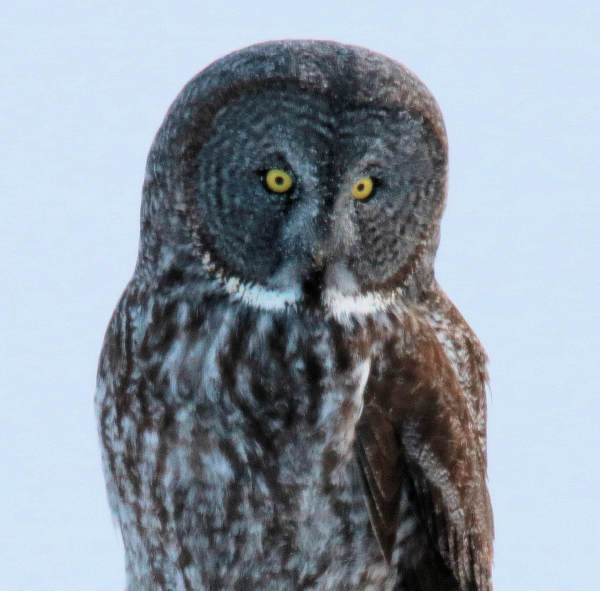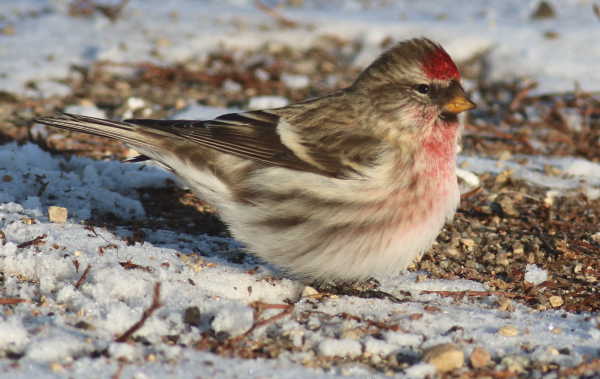
Great Gray Owls are one of the most sought-after birds in North America, so the chance to photograph one as it hunted the Northwoods at sunrise was quite a thrill.

One of the largest owls, Great Grays utilize their sense of hearing even more than their sight, especially after a fresh snowfall.

A Christmas highlight was the appearance of 3 Common Redpolls at the snowy feeding station.

The day after Christmas a young Sharp-shinned Hawk made a couple surprise visits to the feeding station, even providing a photo opportunity.
|
My excitement level was high as I reached the fabled Sax-Zim Bog in the Northwoods of Minnesota at first light. The tall black spruce and tamarack woods provided a foreign landscape filled with some exciting birds that I almost never encounter, so I was on high alert as sunrise revealed my first bird of the day – and one of the most sought-after birds in North America – a Great Gray Owl. Perched stoically atop a roadside pole, the owl was on the hunt, looking this way and that, undoubtedly using its exceptional hearing to pinpoint potential prey – even under the layer of snow.
With the temperature starting to climb from the low of –9 during the 45 minutes I spent within view of the impressive owl, I witnessed 5 strikes on prey as the Great Gray perched at 6 locations that included aspen snags and other tree branches. At one point as I photographed it from the roadside pole, it dropped almost straight down, and I photographed its descent on widespread wings until it smashed through the snow to catch unseen prey – how exciting! During other hunting strikes, the Great Gray seemed to float downward to potential prey. It had been too many years since I spent time observing and photographing a Great Gray Owl, and during that first hour of my Bog visit I could already consider it a successful trip.
Northwoods Feeder Rarities
Pine Grosbeaks were the next species on my list, and this beautiful songbird was periodically being reported at the feeders at the Sax-Zim Bog Welcome Center, along with more commonly encountered birds. Within 15 minutes of arriving at the Center feeders, a flock of about 10 Pine Grosbeaks flew into view, perching at the top of the tallest trees, some feeding on a few aspen buds before eventually dropping down to the feeders filled with sunflower seeds.
Although I have seen a few before, this was really my introduction to Pine Grosbeaks, so I absorbed the views of males and females along with their flight patterns, calls, and favored perches. The females were stunning and more abundant than males, which were more beautiful in the wild than any photo can possibly depict. What a thrill! There was also an abundance of Black-capped Chickadees, Downy and Hairy Woodpeckers, a Red-breasted Nuthatch, and in the surrounding woods I even encountered a Black-backed Woodpecker – my first! It wasn’t a close view of the Black-back, but I could see it was a woodpecker and was quickly able to identify it by its unique call, which is unlike any other woodpecker I’ve ever heard.
The Center’s feeders weren’t the only feeding station site in the area. In fact, there are several impressive feeding stations open to the public provided by generous homeowners. At the top of the list was Lou’s feeders, which lured me to visit with the promise of observing another species of Northwoods grosbeak – Evening Grosbeaks. Like Pine Grosbeaks, I have seen Evening Grosbeaks a couple times before, but just momentarily. As many as 30 Evening Grosbeaks were visiting feeders in Lou’s front yard, which provided me with an exceptional opportunity to observe these beautiful songbirds and absorb their calls as I photographed them. The Evening Grosbeaks definitely made a big impression on me – they are fantastic birds – and how I wished they were among the birds that visit my feeders at home, along with Pine Grosbeaks.
Lou’s yard was filled with more than a dozen different feeders with a variety of styles and foods. Other birds attracted by the feeders and the heated bird bath included a Red-bellied Woodpecker, several Hairy and Downy Woodpeckers, a couple Red-breasted Nuthatches and Blue Jays, many Black-capped Chickadees, and a Wild Turkey even ambled by. I stopped in to Lou’s yard twice, and had the feeders and birds all to myself each time – Thanks Lou! (I also share information about several of the bird feeding stations I visited at the Bog in this issue’s Backyard Birding article.)
Driving between feeder locations I hoped to find other birds, which was indeed the case as I tallied 3 Canada Jays, a black morph Rough-legged Hawk, a rufous morph Ruffed Grouse, many Common Ravens, an adult Bald Eagle, and a Northern Shrike. I searched in vain for a Northern Hawk Owl and more Great Gray Owls, but I was thrilled with all the species I did find along the way. My last stop was a return to the Welcome Center, where I was almost immediately greeted by a small flock of Pine Grosbeaks. I photographed them in the treetops, then at their preferred sunflower seed feeder outside the Center – they are very impressive birds, indeed – and then they were gone.
What fun I had that day, from first light to last light! So why didn’t I stay longer? The weather provided only that one day with some periods of sunlight in the region. In fact, sunlight was rare at best over the past couple weeks and looking forward according to weather predictions. Winter at Sax-Zim is mostly cloudy it seems, which may be dictated somewhat by the presence of giant Lake Superior an hour to the east. I rank the Sax-Zim Bog as one of the best Northwoods birding hotspots, and the work of the Center and its staff, volunteers, and feeder-hosting neighbors is very impressive – especially considering they have only been active for a dozen years. (The website is listed below.)
The Day After Christmas
After returning from the Northwoods, winter took over my homestead and most of the northern states with more cold and lots of snow for 3 days, essentially confining me to birding out my bay windows during a variety of Christmas activities. The bird-based highlight of the period was the smallest bird, a newly arrived male Common Redpoll. In the midst of the 3 days of snowfall, I was excited when 2 more Redpolls arrived Sunday; and that’s when the true highlight arrived outside my windows.
I was tipped off when a male Hairy Woodpecker flushed from the suet feeder, calling loudly as it left. I stepped toward the window bay in time to see the brown flash of a raptor’s spread tail as it took flight behind a nearby bush. I checked all the trees and other structures to see if the smallish raptor had perched nearby, but couldn’t relocate it. There are 3 bird hunters that frequent feeders most often, but this bird was smaller than a Cooper’s Hawk, and my best bet would be that it was a Merlin, considering the size, shape, and color of the raptor flash – and the fact that I hadn’t seen another species of smallish bird of prey in the area for months. The other option would be a Sharp-shinned Hawk, but I hadn’t seen any during the fall season and Sharpies should be far south of this Arctic-like landscape by now.
I monitored the feeders a bit, hoping for a return of the raptor, and noticed almost no birds came to the feeders over the next 15 minutes. A White-breasted Nuthatch finally broke through, followed by a colorful male House Finch, and that’s when the raptor flashed across my windows. I eased up to the windows only to be surprised that the bird was standing just a couple feet away atop the fresh snow – a young Sharp-shinned Hawk! I eased away, then raced for my coat and camera and slipped out the front door with the hope of getting a clear photo. Standing on my front steps, I quickly focused on the rare raptor – rare in my area – and took a few photos as the Sharpie searched for the flutter of a small bird.
After a few ticks of the second hand the small hawk took flight to the northwest, perched again, then continued north. Considering the snowy weather conditions then and in the coming 30 hours with a strong north wind – blizzard conditions really – I expected I might see this Sharp-shinned Hawk again. Certainly, its appearance gave me a jolt of excitement and an unexpected photo opportunity.
SoDak Raptors & Ducks
While I was watching the weather report and waiting for a little sunshine to grace the Sax-Zim Bog, a fully sunny day materialized for my SoDak winter raptor hotspot, which is centered around the capitol city of Pierre. That was December 18th, exactly a month after my first visit, and I returned 12 days later on December 30th. My account of my SoDak trips is provided in the Birding Lifestyles article in this issue. Plus, during the 30th, I had a fruitful opportunity to photograph an interesting variety of ducks I found, which is described in the Bird Photography feature in this issue. (It was a very productive holiday break for me.)
Holiday Birds Update
During our holiday break, in addition to my Bog and SoDak trips, I appreciated periodic sightings of birds that made my day – like the black morph Rough-legged Hawk I found just 2 miles south of home December 15, and the Short-eared Owl I watched hunting 15 miles south December 19. Then there were the Great Horned Owls – one 7 miles southeast December 19, one 15 miles south December 28, and a pair perched shoulder to shoulder in a grove of trees where the species has nested before 10 miles north on December 31st. Almost every day was graced by at least one flock of Snow Buntings, with some flocks numbering in the 50s, others in single digits. Flocks of Horned Larks were equally common, and groups of up to 6 male Ring-necked Pheasants have been obvious in the new year north and south of my office.
The trio of Common Redpolls continue to brighten my feeding station and, finally, the first Blue Jay of the season visited my feeder to collect shelled peanuts a few times this Monday! Hooray. Then yesterday, with a blizzard blowing snow outside, I spied an immature Sharp-shinned Hawk fly in to perch in the elm tree next to my feeding station. It stayed just a moment, but it must be the same Sharpie I photographed the day after Christmas – maybe it will stay longer, if the blizzard doesn’t blow it away. I hope you have had many enjoyable sightings over your holiday season, and I expect you will have many more exciting birds in view during the new year, 2022!
[For more information about the Sax-Zim Bog and see a map of the region you can refer to Friends of Sax-Zim Bog (saxzim.org)]
Article and photos by Paul Konrad
Share your bird sightings and photographs at editorstbw2@gmail.com